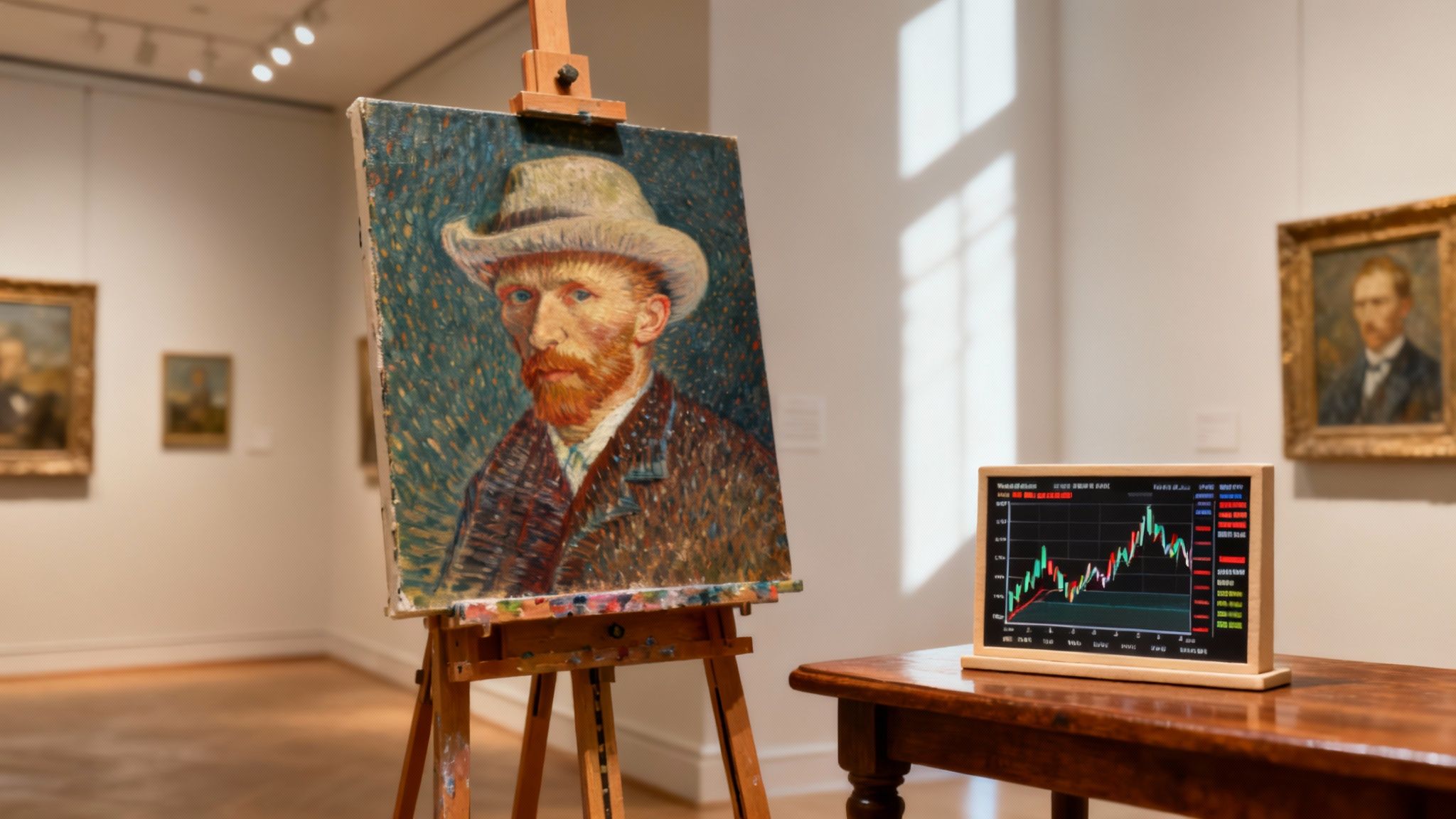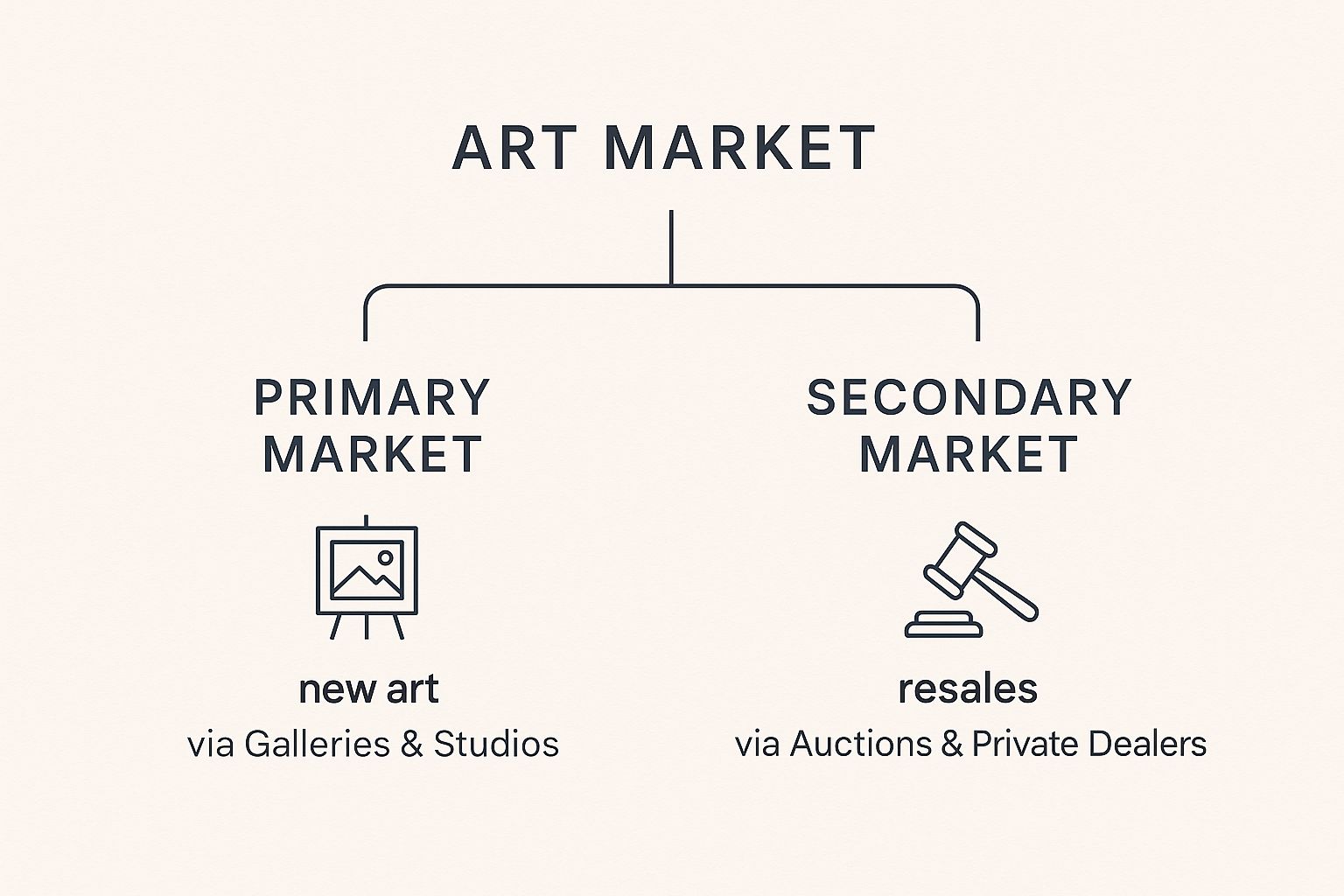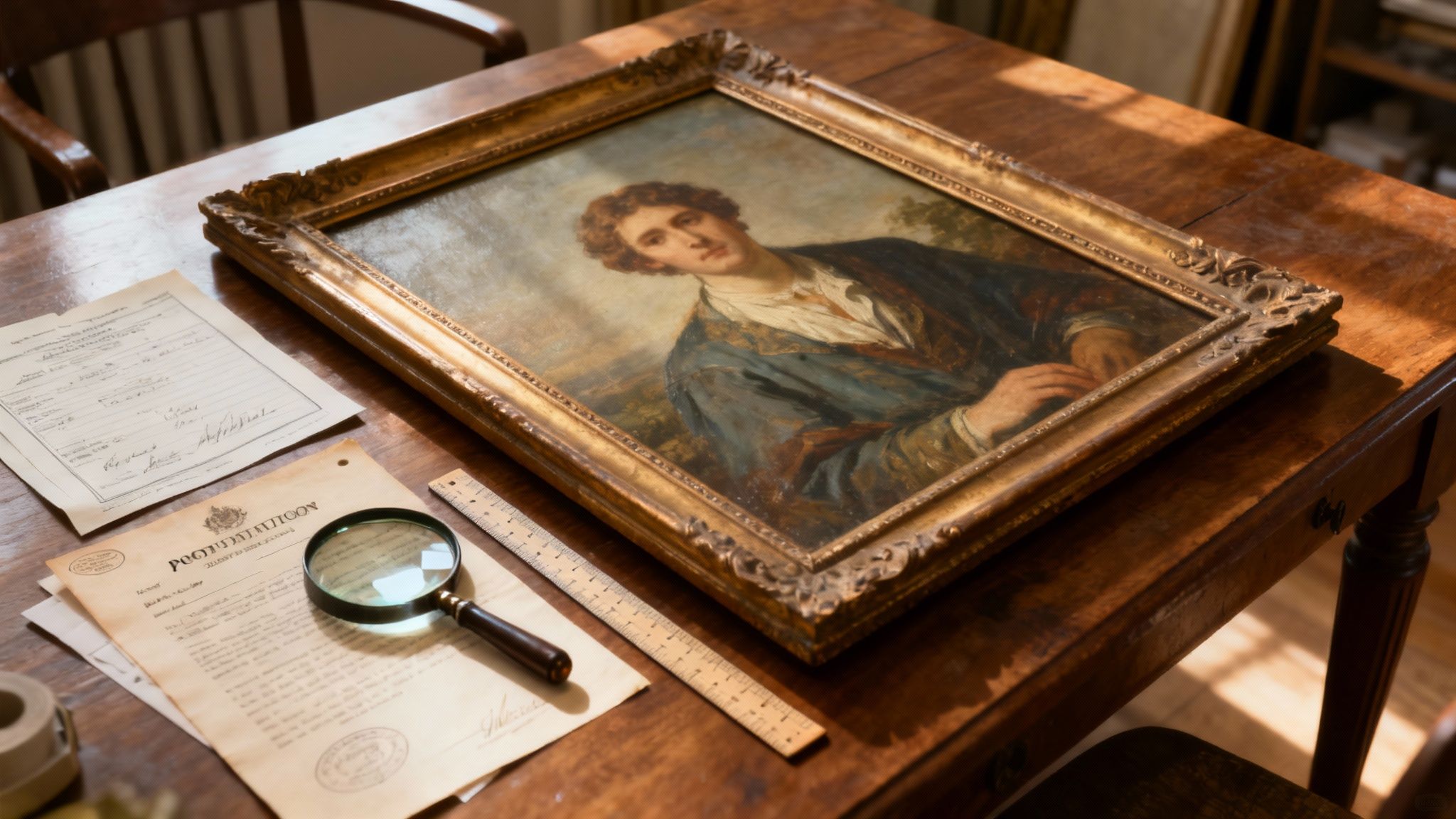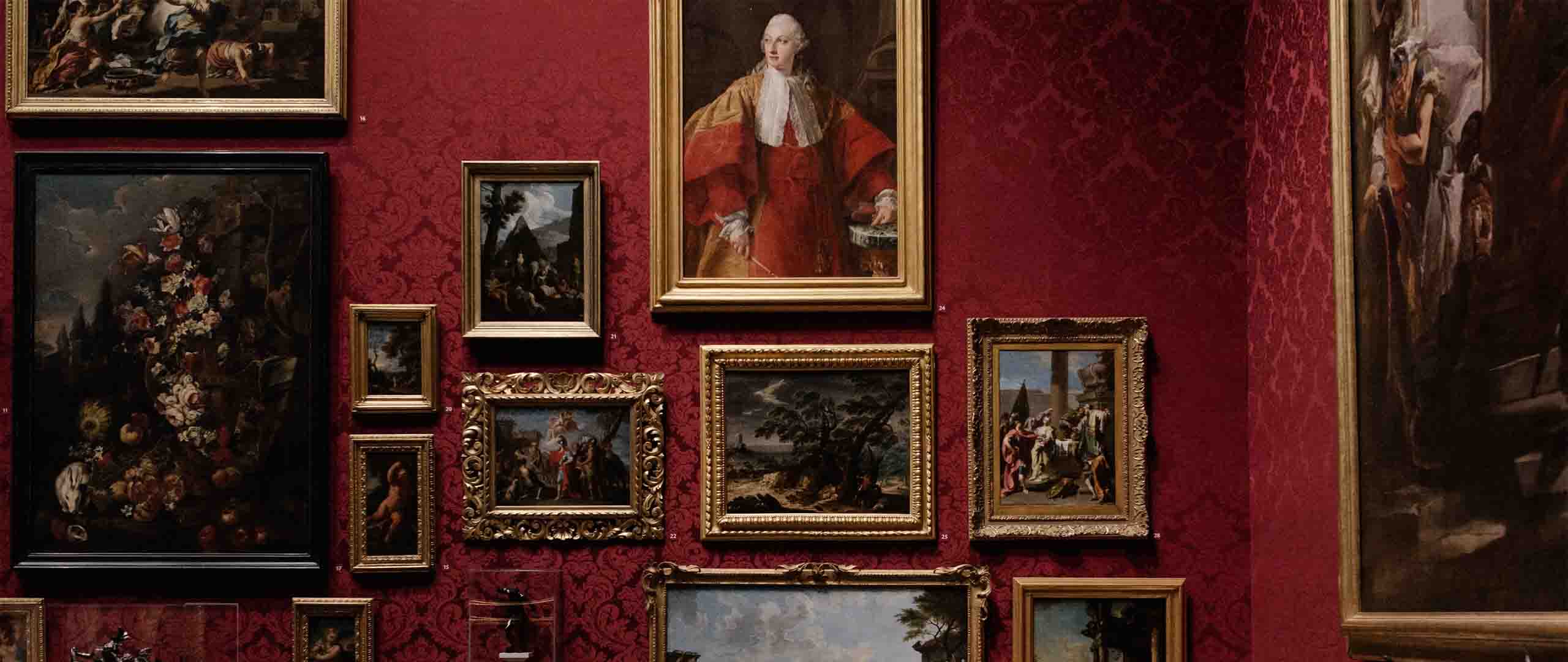Viewing art as an investment is about more than just buying something beautiful to hang on your wall. It's a strategic decision to add a tangible asset to your portfolio, one with a unique blend of cultural significance and serious financial upside. Unlike stocks or bonds, art doesn’t pay dividends, but it acts as a powerful store of value that can appreciate significantly over time. Understanding the art investment market is the first step towards leveraging this unique asset class to protect and grow your wealth.
A Balanced View on Art as a Financial Asset

Treating art as a financial asset means looking past its aesthetic qualities to evaluate its potential performance. This mindset places a painting or sculpture right alongside equities and real estate, but with a completely different set of rules. The value of a masterpiece isn't driven by earnings reports; it's fueled by the artist's reputation, its place in history, and pure market demand.
For high-net-worth individuals, this is where art becomes a powerful tool. The fine art investment market often moves independently of the stock market, which means it can provide a stabilizing effect when economic turbulence hits. Historically, fine art has proven to be an incredibly reliable store of value, protecting wealth from the quiet erosion of inflation.
The Core Benefits of Art in a Portfolio
When you dig into art as a financial instrument, a few key advantages quickly become clear. These are the benefits that draw sophisticated investors looking to build a more resilient financial strategy.
- Portfolio Diversification: Because art has a low correlation to traditional financial markets, it acts as a buffer. It has the potential to reduce your overall portfolio risk during an economic downturn.
- Inflation Hedge: As a tangible asset, fine art’s value tends to hold firm or even rise during inflationary periods. This protects your purchasing power when cash is losing its value.
- Potential for High Returns: The track record speaks for itself. Works by blue-chip and even emerging artists have delivered incredible returns, with some pieces appreciating by thousands of percent over the decades.
- Personal Enjoyment and Cultural Capital: This is the benefit you won't get from a stock certificate. Art is an investment you can live with, appreciate daily, and share with others.
A key consideration for any investor is that art is fundamentally an illiquid asset. Converting a piece into cash can take months or even years, requiring a long-term perspective.
To give you a clearer picture, here’s a quick comparison of how art stacks up against more conventional investments.
Art vs Traditional Investments at a Glance
As you can see, art brings a completely different risk-and-reward profile to the table, which is exactly why it can be such an effective diversifying agent in a well-rounded portfolio.
Understanding Art as an Alternative Investment
Art falls squarely into the category of alternative investments, a class of assets that exists outside of conventional stocks, bonds, and cash. These assets almost always require specialized knowledge and a different way of thinking about risk.
To get a feel for the broader landscape of tangible assets, it can be helpful to look at the strategies behind an effective investment in collectibles like rare coins. The comparison highlights the unique challenges—and opportunities—that come with putting capital into physical, passion-driven assets.
Ultimately, a winning approach to art investing finds the right balance between sharp financial goals and a genuine appreciation for the art itself.
Navigating the Modern Art Market
To treat art as an investment, you first have to understand the world where it’s bought and sold. The art market isn’t a single, unified thing like the New York Stock Exchange. It’s actually two distinct but interconnected ecosystems: the primary market and the secondary market. Succeeding here means knowing the rules, players, and dynamics of each.
The primary market is where a work of art makes its debut. This is the very first sale, when a piece moves directly from the artist's studio into the hands of a collector, usually through a gallery that represents the artist. Think of it as an IPO for an artwork—it's the initial offering. The price is set by the artist and gallery, based on things like reputation, medium, size, and recent sales.
The secondary market, on the other hand, is where art gets resold. This is the world of big-name auction houses like Christie’s and Sotheby’s, as well as private sales handled by dealers and advisors. Here, an artwork’s value is driven by its sales history, its provenance (the documented history of its ownership), and current collector demand. This is where you see the headline-grabbing, record-breaking sales.
This infographic breaks down the two sides of the market simply.

This distinction is crucial because your buying strategy—from due diligence to valuation—will be completely different depending on which market you're operating in.
Understanding Primary Market Dynamics
Investing in the primary market is really about betting on an artist's future potential. It's a chance to get in on the ground floor, acquiring work early in an artist's career when prices are likely lower than they might be later on the secondary market. The whole game is about identifying emerging talent before they hit the big time.
But this market comes with its own unique set of challenges.
- Access is Key: Top galleries are selective. They often prioritize selling to established collectors, museums, or clients they believe will be good stewards of the artist's career. Building relationships with gallerists is absolutely essential.
- Pricing is Opaque: Unlike auction results, primary market prices aren't public record. They're set by the gallery and can be less influenced by broad market trends.
- Higher Risk, Higher Reward: You are investing in potential. If the artist's career takes off, the return can be incredible. If it doesn't, the work may fail to appreciate or even lose value.
How the Secondary Market Operates
The secondary market is far more data-driven. With auction results publicly available, it’s a much more transparent world where the established value of an artwork is tested and proven. This market is dominated by well-known artists with long exhibition histories and a solid track record of sales.
When an artist's work consistently performs well at auction, it builds confidence across the entire market, which can, in turn, boost their primary market prices. This feedback loop is a powerful force in an artist's career trajectory.
Recent global market trends show a fascinating shift. The global art market is navigating a post-pandemic adjustment period, with a move towards more accessible price points. Investors are increasingly looking beyond the ultra-high end, which has created new opportunities in the mid-range and emerging artist segments. This shift reflects a broadening collector base that is more diverse and digitally native than ever before.
Ultimately, your choice between the primary and secondary markets comes down to your risk tolerance, timeline, and overall investment strategy. The primary market offers ground-floor opportunities with emerging talent, while the secondary market provides access to established assets with proven track records. Many sophisticated collectors build portfolios with works from both, balancing the high-growth potential of new artists with the stability of blue-chip names. By understanding how these two ecosystems interact, you can start making strategic decisions instead of just reacting to market noise.
Decoding an Artwork's True Value

Valuing a work of art is a disciplined process, not a wild guess. While you can't just pull up a stock ticker for a Rembrandt, an artwork's price is determined by a concrete set of factors. Getting a handle on these drivers is essential if you're serious about making a sound decision with art as an investment.
Think of it like analyzing a company. Instead of looking at P/E ratios and revenue growth, you're examining an artwork’s ownership history, the artist's reputation, its physical condition, and its place in art history. These elements come together to tell a story of value, scarcity, and desirability.
The Artist's Standing and Reputation
An artist's reputation is the bedrock of an artwork's value. Is the artist a recognized, blue-chip name with a long history of museum shows and strong auction results? Or are they an emerging talent just now getting critical acclaim?
This reputation isn't just about fame; it’s a direct reflection of their influence and contribution to art history. A proper valuation considers the artist’s entire career, including their representation by top-tier galleries and placement in major private and museum collections. A consistent, rising market for an artist’s work is a clear signal of sustained demand—a key indicator for long-term investment potential.
Provenance: The Artwork's Ownership History
Provenance is the documented history of a piece's ownership, tracing its journey from the artist's studio all the way to the present day. Think of it as the artwork's professional resume. A piece that was once part of a famous collection or exhibited in a major museum carries a mark of prestige that can significantly boost its value.
A well-documented provenance is more than just a list of names; it’s a powerful validation of the artwork's authenticity and importance. Gaps in this history can create uncertainty and negatively impact price.
A solid provenance provides a clear chain of custody, which is vital for authentication. Each previous owner adds to the piece’s story and, if prestigious, its desirability. This paper trail is what separates a potential masterpiece from a piece with a questionable past.
Rarity and Condition
The basic principles of supply and demand are fundamental in the art market. The rarity of an artist's work plays a massive role in its valuation. An artist who produced very few pieces during their lifetime will naturally see higher prices for their work compared to a more prolific one.
Here’s how these two factors work together:
- Rarity: This can refer to the total number of works an artist created, but it can also relate to a specific period or series. A rare piece from a celebrated period of an artist's career, for instance, will always command a premium.
- Condition: The physical state of the artwork is non-negotiable. Any damage, restoration, or conservation work must be thoroughly documented in a condition report. An artwork in pristine, original condition will always be valued higher than a similar piece that has been extensively repaired.
An investor has to scrutinize both aspects carefully. A rare work in poor condition might be a much less attractive investment than a more common piece in perfect shape.
Authenticity: The Cornerstone of Value
An artwork's value is entirely dependent on its authenticity. Without it, a piece is essentially worthless from an investment perspective. Authenticity is typically confirmed through expert opinion, inclusion in an artist's official catalogue raisonné, or scientific analysis.
A critical skill for any art investor is knowing how to spot fake antiques, as forgeries and misattributions are very real risks in the market. This makes thorough due diligence and expert verification an absolute must before any acquisition.
When you analyze a piece of art, you are really just piecing together a puzzle. The artist's reputation sets the stage, the provenance tells its story, its condition reveals its physical integrity, and its rarity determines its scarcity. By systematically evaluating each of these factors, you can decode an artwork's true value and build a compelling case for it as a tangible asset in your portfolio.
How Technology Is Reshaping Art Investing
The art world, for centuries a famously closed-off and opaque market, is finally being pried open by digital tools. What was once governed by exclusive relationships and in-person viewings is becoming far more transparent and accessible to a global audience.
This shift is fundamentally changing how investors approach art as an investment. It's making it easier than ever to discover, verify, and acquire valuable pieces from anywhere in the world. For decades, the only real path to serious art ownership was through a handful of major galleries and auction houses. Now, technology is leveling the playing field.
The Rise of Digital Marketplaces and Virtual Viewing
Online platforms have exploded from simple listings into sophisticated, high-stakes sales channels. Major auction houses and galleries now run entire sales online, often complemented by virtual viewing rooms that offer immersive, high-resolution experiences.
This digital migration has shattered geographical barriers. A collector in Tokyo can now confidently bid on a piece hanging in a New York gallery without ever leaving their home. The result is a more liquid and dynamic market where opportunities are no longer tied to a physical location.
The data backs this up. A significant portion of today's collectors, especially younger demographics, are comfortable making major purchases online. This digital acceleration means that art investment platforms are no longer a niche but a central part of the market's infrastructure, broadening access for new investors.
Blockchain and the Quest for Unbreakable Provenance
One of the oldest and most persistent challenges in the art market is proving a piece is authentic and tracking its ownership history, or provenance. Forgeries and incomplete records have always posed a massive risk to investors. Blockchain technology is emerging as a powerful solution to this age-old problem.
By creating a decentralized and unchangeable digital ledger, blockchain can record every transaction and change of ownership for an artwork. Each entry is cryptographically sealed, creating an unbreakable chain of provenance that is transparent and easy for anyone to verify.
This technology acts as a digital passport for an artwork, securely documenting its entire life story. For investors, this adds a critical layer of security and confidence, directly protecting the value of their asset.
This digital certification is a game-changer. It not only combats forgery but also dramatically simplifies the due diligence process. A secure, blockchain-verified provenance can significantly increase an artwork's value by removing any doubt about its history and authenticity—a key factor when evaluating art as an investment.
Augmented Reality Bringing the Gallery Home
A huge hurdle for buying art online has always been the inability to see how a piece will actually look in your own space. It's incredibly difficult to appreciate a painting's scale, texture, and presence through a computer screen. Augmented reality (AR) is bridging this gap in a really compelling way.
New AR-powered apps from galleries and art platforms let collectors use their smartphones to "place" a virtual version of an artwork right on their own walls. This "try before you buy" experience gives you an accurate sense of scale and helps buyers make much more confident decisions.
This tool does more than just enhance the buyer's experience; it also shortens the sales cycle. By removing a major point of uncertainty, AR is empowering a new generation of collectors who are comfortable making significant acquisitions entirely through digital channels. It’s yet another way technology is making the art market more efficient and investor-friendly.
Your First Steps: How to Start Investing in Art
Making the leap from art admirer to art owner is a major step. Building your first collection isn't about chasing trends; it’s a deliberate process that demands a clear strategy. The goal is to create a focused collection that aligns with both your financial objectives and your personal taste.
The first question to answer is where you'll concentrate your efforts. A focused collection is almost always more valuable than a scattered one. Will you pursue emerging contemporary artists whose careers are on the rise? A specific historical period like mid-century modernism? Or a particular medium such as photography or sculpture? Defining your niche is the foundation of a strong collection.
Setting Your Budget and Focus
Once you have a direction, the next step is establishing a realistic budget. This will determine which segment of the market you can access. Whether your entry point is $10,000 or $1,000,000, having a clear financial framework is what prevents emotional purchases and keeps your strategy on track.
A well-defined budget and a clear collecting focus work hand-in-hand. This discipline allows you to build a cohesive and meaningful collection over time, rather than acquiring unrelated pieces impulsively.
With your focus and budget set, you can begin the exciting work of research and discovery. This is where your passion for art as an investment truly comes alive.
- Visit Galleries and Art Fairs: Immerse yourself in the art world. Speak with gallerists, attend artist talks, and see the work in person to get a true sense of its quality and presence.
- Follow Auction Results: Keep an eye on sales from major auction houses. This provides real-time data on which artists and movements are gaining market traction.
- Read Art Publications: Stay informed with industry journals and magazines. They offer critical perspectives and highlight emerging talent.
Where to Make Your First Acquisition
Knowing where to buy is just as important as knowing what to buy. Each venue offers a different experience and level of access. For new investors, starting with reputable sources is crucial to ensure authenticity and fair pricing.
Your primary options include:
- Reputable Galleries: Galleries build long-term relationships with their artists and can provide invaluable context and documentation for each piece.
- Major Art Fairs: Events like Art Basel or Frieze bring together top galleries from around the world, offering a concentrated opportunity to see a wide range of high-quality work.
- Trusted Online Marketplaces: Platforms like Artsy and Artnet have made the market more transparent, allowing you to browse, research, and even purchase from vetted galleries globally.
This approach not only secures valuable assets but also helps in diversifying your overall financial holdings. Just as you would balance stocks and bonds, adding art introduces a tangible asset with a different risk profile. For a deeper understanding of this strategy, you can explore our guide on how to diversify your portfolio.
The art market continues to show strong potential for growth, with projections expecting an expansion from approximately $73.43 billion in 2024 to around $99.65 billion by 2034. This steady climb is fueled by increasing digitalization and a recovering global economy. You can discover more insights about the growing art market on expertmarketresearch.com. By combining diligent research with a clear strategy, you can build a collection that is not only a source of personal joy but also a powerful financial asset.
Common Questions About Investing in Art
Stepping into the art market for the first time naturally brings up a lot of practical questions. When you start thinking about art as an investment, you need clear, straightforward answers to cut through the industry jargon and feel confident in your strategy. Let's tackle some of the most common queries we hear from new investors.
How Much Do I Need to Start Investing?
The idea that you need millions to get started is a common—and thankfully, incorrect—myth. The entry point for art investment is far more accessible than most people think. You can often acquire high-quality prints or unique works on paper from established artists for just a few thousand dollars.
The emerging artist market also offers exciting opportunities to buy original works for under $5,000. The real key is to define a budget you're comfortable with and focus on a segment of the market that aligns with your financial goals. On top of that, fractional ownership platforms now allow you to invest in a share of a high-value masterpiece with a much smaller capital outlay.
What Is the Biggest Mistake to Avoid?
The most frequent pitfall for new investors is buying with their ears instead of their eyes. It's easy to get caught up chasing hype without developing a genuine understanding of the artist or the work itself. That approach almost always leads to impulsive, emotionally driven decisions rather than strategic ones.
Another critical error is skipping the due diligence. You must always verify an artwork's provenance (its history of ownership), condition, and authenticity with reputable advisors or galleries before you even think about buying. This step is absolutely non-negotiable for protecting your investment.
A successful strategy is a blend of financial goals, personal passion, and deep research. Never skip the homework required to understand what you're buying and, more importantly, why it holds value.
How Do I Sell Art From My Portfolio?
Selling a piece of art is a strategic process, not a quick transaction like selling a stock. Your main options are auction houses, private sales through a dealer or gallery, and consignment. The right choice depends entirely on the specific artwork, the artist's current market, and the timeline you have in mind.
Auction houses offer the widest exposure but come with significant commissions. Private sales are more discreet and can be much faster, but you're reaching a smaller, more targeted pool of potential buyers.
Working with an art advisor or a gallery specialist is crucial here. They can help you build a sales strategy that maximizes your return and handles all the complexities of the sale—including the tax implications. When it's time to sell, understanding how to manage your gains is key. You can learn more about strategies to reduce capital gains tax in our detailed guide to ensure you retain as much of your return as possible.
At Commons Capital, we specialize in guiding high-net-worth individuals through the complexities of alternative assets like art. Discover how our financial advisory services can help you integrate art into a sophisticated and resilient investment portfolio. https://www.commonsllc.com






